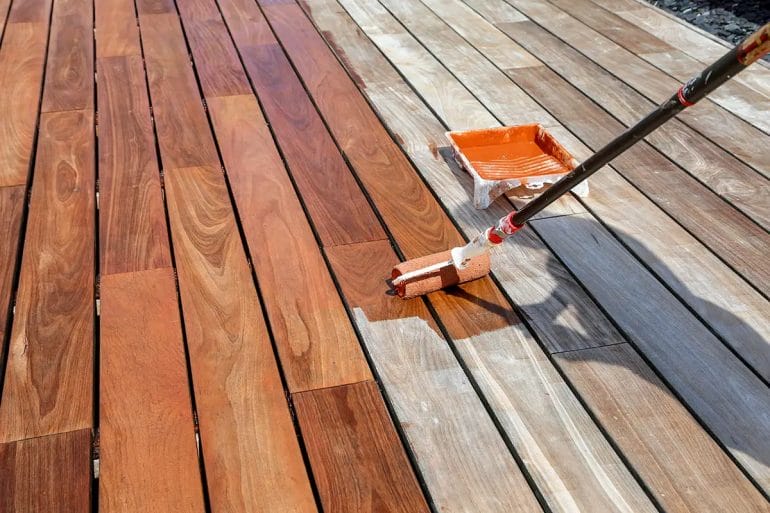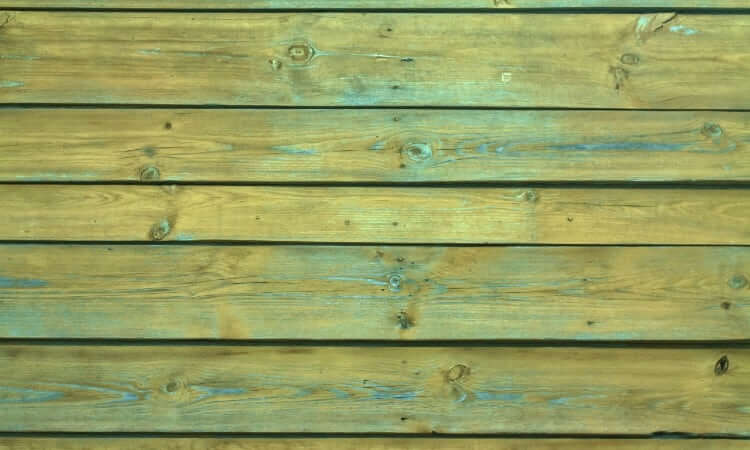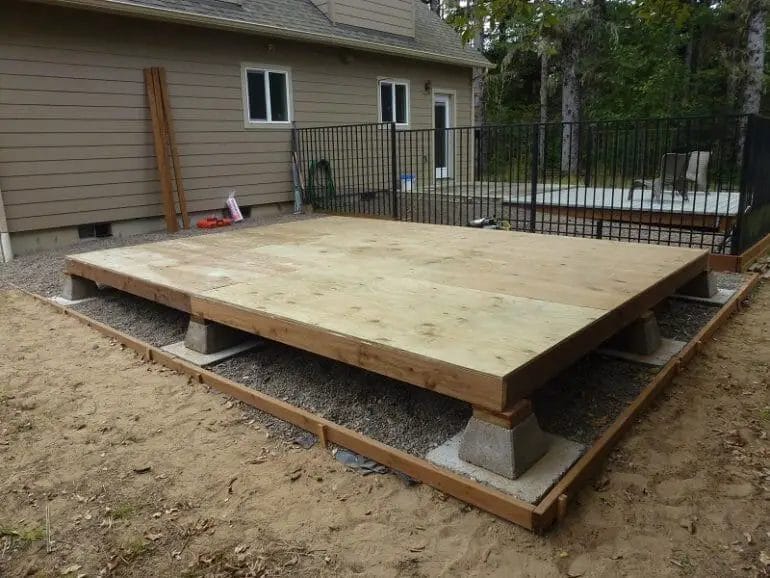Pressure treated wood is designed to resist moisture and decay, making it suitable for outdoor projects and areas with high humidity. Despite its resistance, pressure treated wood can still get wet. However, thorough drying and occasional maintenance can help prevent any potential damage caused by moisture. It is important to remember that even though pressure treated wood is treated, it is not completely waterproof and should still be protected from excessive exposure to water.

Tips for Protecting Pressure Treated Wood from Moisture
Pressure treated wood is commonly used in outdoor applications such as decks, fences, and outdoor furniture. It is treated with chemicals to resist rot, decay, and insect infestation. However, even pressure treated wood is not completely immune to the damaging effects of moisture.

In this section, we will provide you with some useful tips to help protect your pressure treated wood from moisture, extending its lifespan and maintaining its structural integrity.
1. Apply a Water Repellent Sealer
One of the most effective ways to protect pressure treated wood from moisture is to apply a water repellent sealer. This type of sealer creates a barrier on the surface of the wood, preventing water from penetrating into the grains. Be sure to choose a sealer that is specifically designed for pressure treated wood and follow the manufacturer’s instructions for application.
2. Keep the Wood Elevated
When using pressure treated wood for outdoor structures, it is important to keep it elevated off the ground. This helps to prevent moisture from seeping into the wood from the bottom. Use concrete or stone pavers to create a solid foundation for your structure, ensuring that the wood is not in direct contact with the ground.
3. Regularly Clean and Inspect
Maintaining the cleanliness of pressure treated wood is essential for its longevity. Regularly clean the surface of the wood using a mild detergent and water. This will help remove dirt, debris, and any organic matter that can trap moisture against the wood. Additionally, perform routine inspections to identify any signs of damage or decay, and address them promptly.
4. Provide Adequate Ventilation
Proper ventilation is crucial for preventing moisture buildup around pressure treated wood. Ensure that there is sufficient airflow in the area where the wood is located. This can be achieved by leaving gaps between deck boards, installing vented soffits, or using lattice panels instead of solid walls.
5. Avoid Direct Contact with Water Sources
To protect pressure treated wood from excessive moisture, avoid direct contact with water sources whenever possible. For example, if you have a deck made of pressure treated wood, make sure to use water-resistant rugs or mats near water features, such as pools or hot tubs. This will help minimize water exposure to the wood surface.
6. Apply Stain or Paint
Another effective way to protect pressure treated wood from moisture is by applying a stain or paint. These finishes create an additional layer of protection, adding to the wood’s resistance against water penetration. Choose a high-quality stain or paint that is designed for exterior use and follow the manufacturer’s instructions for application.
7. Regularly Reapply Sealers and Finishes
To ensure continuous protection against moisture, it is important to regularly reapply water repellent sealers, stains, or paints. Over time, the protective layer may wear off due to weather exposure. Follow the recommended maintenance schedule provided by the product manufacturer to keep your pressure treated wood in optimal condition.
In summary, protecting pressure treated wood from moisture is essential for maintaining its durability and appearance. By following these tips, you can enhance the lifespan of your pressure treated wood and enjoy its benefits for years to come.

Can Pressure Treated Wood Be Used for Outdoor Applications?
Pressure treated wood is a popular choice for outdoor applications due to its durability and resistance to rot and decay. This type of wood is infused with preservatives that protect it from various environmental factors, making it suitable for a wide range of outdoor projects. In this section, we will explore the benefits and limitations of pressure treated wood for outdoor use.
The Benefits of Pressure Treated Wood
One of the main advantages of pressure treated wood is its ability to withstand moisture and insect damage. The preservatives used in the treatment process penetrate deep into the wood, providing long-lasting protection against rot, decay, and termite infestation.
Another benefit of pressure treated wood is its affordability. Compared to other types of wood that require additional treatments or coatings to make them suitable for outdoor use, pressure treated wood is a cost-effective option. It is readily available and widely used in the construction industry.
Pressure treated wood is also known for its strength and durability. It can withstand harsh weather conditions, including heavy rain, snow, and extreme temperatures, without warping or deteriorating. This makes it an ideal choice for outdoor structures such as decks, fences, and pergolas.
The Limitations of Pressure Treated Wood
While pressure treated wood offers many benefits, it does have some limitations that should be considered before using it for outdoor applications.
Firstly, pressure treated wood contains chemicals that can be harmful to humans and the environment. The preservatives used in the treatment process include copper, chromium, and arsenic, which can leach out of the wood over time. It is important to handle and dispose of pressure treated wood properly to minimize any potential risks.
Additionally, pressure treated wood requires regular maintenance to ensure its longevity. It is recommended to apply a water repellent or sealant on a regular basis to protect the wood from moisture and UV damage. Without proper maintenance, the wood may start to show signs of decay or discoloration.
Best Uses for Pressure Treated Wood
Pressure treated wood is most commonly used for outdoor applications that require resistance to moisture and decay. Some of the best uses for pressure treated wood include:
- Decking: Pressure treated wood is a popular choice for building decks due to its durability and affordability.
- Fencing: Pressure treated wood can be used to construct sturdy and long-lasting fences.
- Garden Structures: Pergolas, arbors, and trellises made from pressure treated wood can add beauty and functionality to outdoor spaces.
- Outdoor Furniture: Pressure treated wood can be used to build durable and weather-resistant outdoor furniture.
It is important to note that pressure treated wood should not be used for applications where it will come into direct contact with food or be used in areas with frequent hand contact, such as handrails or benches.
In summary, pressure treated wood is a suitable choice for outdoor applications due to its durability, resistance to rot and decay, and affordability. However, it is important to consider the limitations and proper maintenance required for this type of wood. By understanding these factors, you can make an informed decision on whether pressure treated wood is the right choice for your outdoor project.

The Importance of Properly Drying Pressure Treated Wood
Pressure treated wood is a popular choice for outdoor projects such as decks, fences, and pergolas. The treatment process involves injecting the wood with preservatives to protect it from rot, decay, and insect damage. While pressure treated wood is designed to withstand outdoor conditions, it is important to properly dry the wood before using it in any project. In this section, we will discuss the reasons why proper drying is crucial for pressure treated wood and the steps you can take to ensure optimal drying.
1. Minimizing Shrinkage
One of the main reasons why proper drying is important for pressure treated wood is to minimize shrinkage. When wood is first treated, it absorbs a significant amount of moisture. This moisture needs to be released slowly and evenly to prevent the wood from warping, twisting, or cracking as it dries. If the wood is not properly dried, it can lead to structural issues and a decrease in the overall lifespan of the project.
2. Enhancing Stain and Sealant Performance
Properly drying pressure treated wood also plays a crucial role in enhancing the performance of stains and sealants. Since the wood is initially saturated with moisture during the treatment process, it is important to allow it to dry thoroughly before applying any type of finish. If the wood is still wet, the stain or sealant may not adhere properly, resulting in a blotchy or uneven finish. Additionally, excess moisture trapped within the wood can lead to mold or mildew growth over time.
3. Preventing Long-Term Issues
By ensuring that pressure treated wood is properly dried before installation, you can help prevent long-term issues such as decay or rot. If the wood is used while still wet, it can become a breeding ground for fungi and bacteria. These organisms can break down the wood fibers over time, compromising its structural integrity. By allowing the wood to dry thoroughly, you can minimize the risk of these issues and ensure the longevity of your outdoor projects.
Steps for Properly Drying Pressure Treated Wood
Now that we understand the importance of properly drying pressure treated wood, let’s discuss the steps you can take to ensure optimal drying:
- Stack the wood: Start by stacking the pressure treated boards, leaving an even gap between each board. This allows air to circulate around the wood and facilitates drying.
- Cover the stack: Use a tarp or plastic sheet to cover the stacked wood. This will protect it from rain or moisture while still allowing air to circulate.
- Keep the stack off the ground: Place the stack of wood on pallets or blocks to keep it elevated off the ground. This prevents moisture from seeping up from the ground and prolongs the drying process.
- Monitor the moisture content: Use a moisture meter to regularly check the moisture content of the wood. Ideally, the moisture content should be around 15% or lower before using the wood in any project.
- Allow sufficient drying time: The drying time for pressure treated wood can vary depending on various factors such as climate and humidity. It is recommended to allow at least two to three weeks for the wood to dry thoroughly before installation.
In Summary
Properly drying pressure treated wood is essential to minimize shrinkage, enhance stain and sealant performance, and prevent long-term issues such as decay or rot. By following the steps outlined above, you can ensure that your pressure treated wood is dry and ready for use in your outdoor projects. Remember to allow sufficient drying time and regularly monitor the moisture content for optimal results.
Common Mistakes to Avoid When Using Pressure Treated Wood Outdoors
Pressure treated wood is a popular choice for outdoor projects due to its durability and resistance to rot and decay. However, there are certain mistakes that people often make when using pressure treated wood outdoors. These mistakes can lead to premature deterioration of the wood and undermine the longevity of your outdoor structures. In this section, we will discuss some common mistakes to avoid when using pressure treated wood outdoors.
1. Not Allowing the Wood to Dry Properly
One of the most common mistakes is not allowing the pressure treated wood to dry properly before using it in your outdoor project. Pressure treated wood is typically delivered to the customer while it is still wet from the treatment process. It is important to let the wood dry out completely before installation to avoid issues such as warping, splitting, and shrinkage.
To ensure proper drying, store the wood in a dry and well-ventilated area for at least a few weeks. This will allow the moisture content to stabilize and the wood to acclimate to its surroundings. Additionally, when using the wood in your project, make sure to leave enough space between the boards to allow for proper air circulation and drying.
2. Using the Wrong Fasteners
Another common mistake is using the wrong type of fasteners when working with pressure treated wood. The chemicals used in the pressure treatment process can be corrosive to certain metals, such as untreated steel or iron. If you use the wrong fasteners, they can react with the chemicals in the wood and quickly deteriorate, compromising the structural integrity of your outdoor structure.
It is recommended to use fasteners that are specifically designed for use with pressure treated wood, such as stainless steel or hot-dipped galvanized nails, screws, or bolts. These materials are more corrosion resistant and will hold up better in outdoor conditions.
3. Failing to Seal the Wood
While pressure treated wood is resistant to rot and decay, it is still susceptible to moisture damage over time. Failing to seal the wood can lead to water penetration, which can cause the wood to swell, warp, and eventually rot.
To protect your pressure treated wood from moisture damage, it is essential to apply a water repellent or wood sealer. This will create a protective barrier that prevents water from penetrating the wood while allowing it to breathe. It is recommended to reapply the sealer every few years to maintain its effectiveness.
4. Not Providing Proper Ventilation
Proper ventilation is crucial when using pressure treated wood in outdoor projects. Without sufficient airflow, moisture can become trapped between the wood and other surfaces, leading to the growth of mold, mildew, and rot.
When building structures such as decks or fences, make sure to provide adequate spacing between the boards to allow for air circulation. Additionally, avoid placing pressure treated wood directly against surfaces such as concrete or soil, as these can retain moisture and promote decay.
5. Neglecting Regular Maintenance
Lastly, neglecting regular maintenance is a common mistake that can significantly decrease the lifespan of your pressure treated wood outdoor structures. Despite its durability, pressure treated wood still requires routine maintenance to keep it in optimal condition.
Regularly inspect your outdoor projects for signs of damage, such as cracks, splintering, or discoloration. If necessary, replace any damaged boards or parts to prevent further deterioration. Additionally, consider applying a fresh coat of sealant every few years to enhance the wood’s resistance to moisture and UV rays.
In summary, when using pressure treated wood outdoors, it is important to allow the wood to dry properly, use the correct fasteners, seal the wood, provide proper ventilation, and perform regular maintenance. By avoiding these common mistakes, you can ensure the longevity and durability of your outdoor structures.
FAQs
Can pressure treated wood get wet?
Yes, pressure treated wood can get wet. However, it is treated with preservatives that make it more resistant to moisture, rot, and decay compared to untreated wood. But it is still important to protect pressure treated wood from excessive moisture to maintain its durability and longevity.
Conclusion
In conclusion, pressure-treated wood can indeed get wet. Despite its treatment, which involves the infusion of chemicals to resist rot and decay, water can still penetrate the wood over time. However, pressure-treated wood is more resistant to moisture compared to untreated wood. It is important to note that prolonged exposure to water can still lead to eventual decay and damage to the wood. To mitigate this, regular maintenance and proper sealing of pressure-treated wood are recommended to ensure its longevity and durability.
Overall, while pressure-treated wood provides some level of protection against moisture, it is not completely impervious to water. Therefore, it is essential to take necessary precautions to prevent excessive exposure and ensure the longevity of your pressure-treated wood projects.